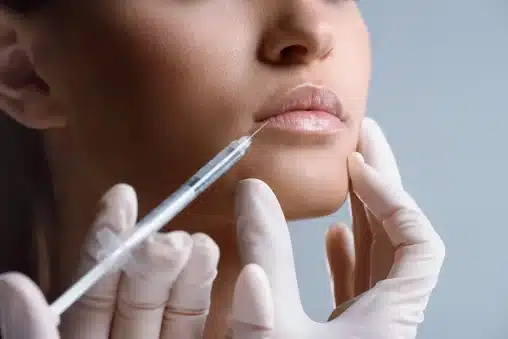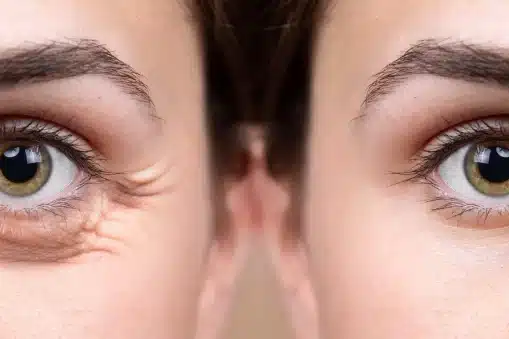Excessive gingival display (EGD), widely known as a “gummy smile,” is clinically defined as the visible exposure of more than 3 millimeters of gingiva upon full smiling.
It can certainly be classified among minor cosmetic concerns, yet EGD significantly disrupts facial balance because of disproportion between the lips, teeth, and gingival tissue. For many people, this reduces self-esteem and makes them reluctant to smile confidently.
Historically, treatment options for EGD have leaned heavily on surgical interventions, from gingivectomy and crown lengthening to more extensive orthognathic surgery. These methods are effective but carry a significantly higher risk and longer recovery.
That’s why the introduction of botulinum toxin type A (BTX-A) as a therapeutic tool has changed treatment completely.
Let’s find out how.
The Anatomy Behind a Gummy Smile
It might look simple, but a gummy smile has a multifactorial anatomical origin. It results from variations in muscle function, skeletal structure, dental positioning, or soft tissue dynamics.
So, to begin with, we have to pinpoint the primary cause or more often, a combination of causes.
- Muscular Contributors: The elevation of the upper lip during a smile is largely governed by the coordinated action of several perioral muscles, including the levator labii superioris, levator labii superioris alaeque nasi, and zygomaticus minor. When these muscles exhibit hyperactivity they pull the upper lip higher than normal. Studies have shown that hyperfunction of these elevator muscles is a common, yet often underdiagnosed, cause of EGD.
- Skeletal and Dental Factors: While muscular causes are common, skeletal and dental anomalies frequently underlie more severe or persistent forms of gummy smile. Vertical maxillary excess (VME) is one of the potential culprits. Similarly, dentoalveolar extrusion, where the teeth and surrounding alveolar bone grow excessively, can lead to disproportionate gingival exposure. Unlike muscular causes, skeletal and dental contributors are typically less responsive to BTX-A alone.
- Lip Dynamics: The hypermobile upper lip is another distinct and often overlooked contributor to EGD. Defined by an upper lip movement exceeding 6–8 mm during smiling (compared to the average of 6 mm), this condition creates a gummy appearance even in the absence of dental or skeletal irregularities. Hypermobile lips are frequently idiopathic, meaning they occur without an identifiable underlying cause, and are often seen in younger patients. Botulinum toxin limits excessive lip elevation in these cases.
Regular Gummy Smile Treatment Methods
Before, surgical and orthodontic methods were the only ones. As we have already said, they are undeniably effective, but come with considerable drawbacks, from extended recovery periods to varying degrees of risk.
Surgical Interventions
Surgeries are still used, but they should be limited to severe cases.
Gingivectomy and Crown Lengthening
These surgeries improve the ratio between tooth length and visible gum tissue. Gingivectomy is the excision of excess gingiva, while crown lengthening also requires the recontouring of supporting bone to expose more of the clinical crown. These procedures significantly enhance dental aesthetics. Nevertheless, periodontal health and tooth stability can be compromised.
Orthognathic Surgery
In cases where vertical maxillary excess (VME) is diagnosed, orthognathic surgery remains the best option. This involves repositioning the maxilla to reduce vertical facial height and normalize the gingival look. These procedures are complex and require general anesthesia, leading to significant healing time.
Lip Repositioning Surgery
Lip repositioning is a less invasive surgical alternative for reducing the upward movement of the upper lip. Here, the goal is to remove a strip of mucosa from the inner part of the upper lip and suturing it closer to the gingivolabial junction. This restricts the elevator muscles and decreases the range of lip motion during smiling. As outlined in multiple PubMed studies, lip repositioning is recommended to patients with hypermobile lips, but the success rate is not 100% and data is still limited.
Orthodontic Approaches
Intrusion of anterior teeth is less invasive, but also significantly slower than surgery and Botox. Orthodontic treatment addresses dentoalveolar extrusion by applying controlled forces on anterior maxillary teeth, thereby reducing gingival display. This is mostly for younger patients or together with other treatments.
Botox: A Minimally Invasive Alternative
Aesthetic dentistry has become an important part of both dentistry and aesthetic medicine. Botox has become the solution for patients with gummy smiles.
Without altering hard or soft tissues irreversibly, with Botox you get a non-surgical, low-risk alternative to the most popular and effective treatments so far.
BTX-A targets the root cause of many gummy smiles — muscular hyperactivity.
Mechanism of Action
Botulinum toxin type A is used to block nerve signals to muscles. Specifically, it inhibits the presynaptic release of acetylcholine (the neurotransmitter responsible for muscle contraction) at the neuromuscular junction.
When administered in carefully selected doses, BTX-A temporarily blocks facial elevator muscles used in upper lip movement. This leads to a partial and reversible paralysis, significantly reducing their contraction strength during expressive movements like smiling.
In the context of EGD, the most commonly overactive muscles are the levator labii superioris, levator labii superioris alaeque nasi, and zygomaticus minor. By reducing the activity of these muscles, BTX-A leaves the upper lip in a more inferior position during smiling.
Procedure Overview
This is how most Botox procedures for gummy smile look like:
- Injection Sites: The precision of injection is most important to the success of BTX-A therapy for gummy smiles. The target muscles must be accurately located via anatomical landmarks and palpation. These muscles originate from the infraorbital margin and nasal bones and insert along the upper lip. Most clinicians inject at the Yonsei point, a standardized anatomical location giving reliable diffusion to both target muscles. Misplacement causes asymmetry and adverse effects such as upper lip droop.
- Dosage and Technique: Dosage is individual, based on muscle bulk, lip length, and smile dynamics, but a common starting point is 2.5 units of BTX-A injected bilaterally into each of the target muscles (5 units per side). A fine-gauge 30- or 32-gauge needle is usually the best choice. Clinical experience and evidence suggest that slight adjustments in dose and injection vector may be required for patients with severe hyperfunction or unique anatomical patterns.
Duration and Maintenance
The effects of BTX-A are not immediate. Most patients begin to notice a reduction in upper lip elevation within 3 to 5 days, with peak effect typically reached at around 10 to 14 days. This time frame should be communicated clearly to patients during consultation to manage expectations.
The clinical effect generally lasts 3 to 6 months, depending on factors such as dosage, individual muscle metabolism, and the patient’s facial expressiveness. Over time, as axonal sprouting and synaptic reconstitution occur, muscle activity resumes, gradually restoring the original gums look.
Therefore, repeat treatments are necessary to maintain results. Routine follow-up should be scheduled around the 2-week mark post-injection to check symmetry and efficacy. Minor touch-ups may be indicated in 10–15% of patients. Long-term safety is well-established.
Potential Side Effects
BTX-A is generally well-tolerated, with a very good safety profile. Common side effects are mild and temporary, including:
- Injection Site Reactions: Redness, swelling, or bruising.
- Asymmetry: Uneven smile due to differential muscle response.
- Overcorrection: Excessive muscle relaxation leading to a flattened smile.
These effects most often resolve without intervention.
Integrating Botox into Aesthetic Dental Practice
Of course, the most important thing is to learn injection techniques, but familiarity with facial anatomy and precise diagnostics are equally important. These are three pillars of integration that every dental practitioner must address:
- Training and Certification: Before administering BTX-A, dental professionals must undergo specialized training that extends well beyond conventional dental education. Comprehensive programs should cover facial musculature, neurovascular landmarks, dosing strategies, and the management of adverse effects such as ptosis or asymmetry. Certification by a recognized body (depending on the jurisdiction) validates a clinician’s capability.
- Patient Assessment: As we know, all cases of excessive gingival display (EGD) stem from the same cause. Differentiating between muscular hyperactivity, skeletal discrepancies, dental extrusion, or lip hypermobility is essential for determining whether Botox is appropriate. Assessment should include detailed clinical examination, photographic analysis, documentation of the smile line, upper lip mobility, and gum exposure in both static and dynamic states.
- Combining Treatments: Undoubtedly, Botox is highly effective as a stand-alone fix for muscle-dominant gummy smiles, but its equally good as part of broader treatment planning. Periodontists, orthodontists, and oral surgeons should be involved in making a treatment plan.
Wrapping Up
Compared to surgical interventions, Botox is a more accessible, lower-risk solution with minimal disruption to the patient’s daily life. This major advancement in modern dentistry significantly facilitates not only the patient’s recovery, but also the procedure for the clinician.
Beyond its technical benefits, what truly sets this approach apart is its adaptability. BTX-A makes it possible for dental professionals to address individual aesthetic concerns precisely, and it can be easily integrated into broader smile design. It also opens up new possibilities for interdisciplinary collaboration between dental specialists and aesthetic physicians, ultimately benefiting the patient on all fronts.
The position of Botulinum toxin type A as a solver of this problem is firmly established for years to come.
Frequently Asked Questions (FAQs)
How does Botox compare to dermal fillers in managing gummy smiles?
Botox targets the muscle activity responsible for excessive upper lip elevation, while dermal fillers primarily add volume to balance proportions. For dynamic smile correction, Botox is generally preferred due to its direct action on hyperactive levator muscles. Fillers may be used adjunctively in volume-deficient areas, but not as a standalone solution for gummy smiles.
Can Botox be used as a diagnostic tool before surgical gummy smile correction?
Yes, Botox can serve as a reversible diagnostic trial to predict surgical results. By relaxing the upper lip elevator muscles temporarily, it shows how muscle modification would impact smile aesthetics post-surgery. It’s very good for patient expectations and surgical planning.
Is there a difference in Botox treatment approach between male and female patients?
There can be anatomical and aesthetic differences in treatment planning. Women often have a higher smile line and thinner upper lips, which may require more conservative units to preserve natural expressiveness. Men usually need slightly deeper injections due to stronger muscle mass.
Are there contraindications for Botox treatment in patients with autoimmune conditions?
Yes, Botox should be used cautiously or avoided in patients with neuromuscular disorders such as myasthenia gravis or Lambert-Eaton syndrome. General autoimmune diseases aren’t absolute contraindications, but a thorough medical evaluation is necessary. Patients on immunosuppressants also require closer monitoring.
How does patient age affect the efficacy and planning of Botox for gummy smiles?
Younger patients have more responsive muscle tissue and require smaller doses for effective correction. In older patients, tissue laxity or volume loss might necessitate combination approaches, including fillers or surgical interventions.
What are the implications of repeated Botox treatments on muscle atrophy in the upper lip?
With repeated treatments, some degree of muscle atrophy occurs due to disuse, which prolongs aesthetic results. However, overtreatment leads to unnatural smile expressions or poor lip mobility.
References
Fatani B. An Approach for Gummy Smile Treatment Using Botulinum Toxin A: A Narrative Review of the Literature. Cureus. 2023 Jan 21;15(1):e34032. doi: 10.7759/cureus.34032. PMID: 36824551; PMCID: PMC9941039.
Rasteau S, Savoldelli C, Winter C, Lerhe B, Castillo L, Kestemont P. Botulinum toxin type A for the treatment of excessive gingival display – A systematic review. J Stomatol Oral Maxillofac Surg. 2022 Nov;123(6):e717-e723. doi: 10.1016/j.jormas.2022.05.016. Epub 2022 May 14. PMID: 35577306.
Rojo-Sanchis C, Montiel-Company JM, Tarazona-Álvarez B, Haas-Junior OL, Peiró-Guijarro MA, Paredes-Gallardo V, Guijarro-Martínez R. Non-Surgical Management of the Gingival Smile with Botulinum Toxin A-A Systematic Review and Meta-Analysis. J Clin Med. 2023 Feb 10;12(4):1433. doi: 10.3390/jcm12041433. PMID: 36835971; PMCID: PMC9965818.
Zengiski ACS, Basso IB, Cavalcante-Leão BL, Stechman-Neto J, Santos RS, Guariza-Filho O, Zeigelboim BS, Taveira KVM, de Araujo CM. Effect and longevity of botulinum toxin in the treatment of gummy smile: a meta-analysis and meta-regression. Clin Oral Investig. 2022 Jan;26(1):109-117. doi: 10.1007/s00784-021-04223-w. Epub 2021 Oct 15. PMID: 34652491.



0 Comments